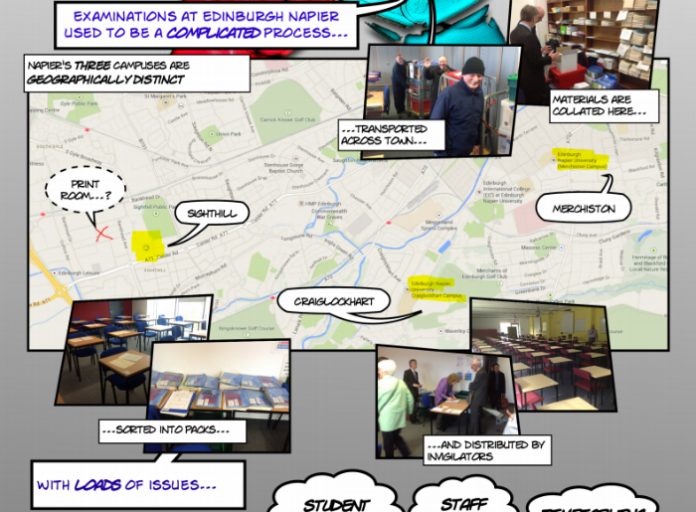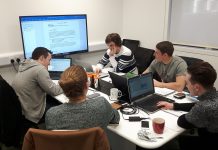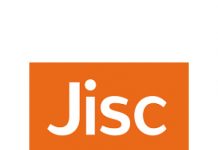
When Edinburgh Napier University trialled streamlining the logistics around the production of exam papers they expected the changes would save some time for staff. But the benefits produced went further than that as Louise McElhone and Steve Yorkstone explain.
How did the project come about?
LM: The Student Administration team at Edinburgh Napier is responsible for running major student facing events such as matriculation, graduation, and of course examinations. The team support approximately 20,000 individual exam sittings per academic year across three campuses based in Edinburgh.
In 2013 the team approached our internal process improvement department, and asked if they could investigate the possibility of streamlining the team’s predominantly paper-based business processes.
I don’t think the team members quite realised what they were letting themselves in for! Our internal process improvement colleagues, Andrew McKendrick and Steve Yorkstone, worked with us for a number of months, and looked primarily at how we ran examinations. They investigated the process across the university, and together with members of our team, and colleagues across the university, we came up with some great ideas.
The report Steve and Andrew produced suggested changing the logistics around the production of exam papers, specifically using our in house print services. They also proposed better use of our estate to support the exam period and logging of incidents to enable root cause problem solving across the institution.
SY: After trialling the new way of working over a resit exam session, the new process was rolled out by the summer exam session in 2014. Initially the benefits were pretty good, we saved ourselves lots of time, saved lots of trips for the students between campuses.
We produced a case study about it:
Now it’s 2016 and we’ve been working with this new process for two years, we thought it would be worth reflecting if it was worth the effort longer term, or, if these benefits were good at the time… but not sustained?
What initially surprised you?
LM: What shocked us about the research we undertook was the number of times someone touched an exam paper before it reached the student. We didn’t realise that a paper had 13 to 30 physical handovers between people before it reached a student, each time introducing another opportunity for error. We thought at the time we could reduce the number of handovers, without having a negative impact on quality.
SY: The other surprise was that were able to give our academics an additional two weeks prep time on deadlines. We waited until we’d trialled the new way of working before implementing it for resits, but we realised that we could allow our academics an additional two weeks to create their papers, meeting the call from our academic colleagues to be afforded more time in order to create even more relevant papers.
What lessons had we learned?
LM: Thinking about how we did the improvement, how we made the change to the new way of working, there are a number of things we learnt.
It was far more labour intensive to do the research than we had initially considered. We thought it would be just to do with what was in our offices… But we realised that in order to really improve the process, we had to step outside our office and look at the complete process across the entire university. This time was worth it though because this was how we were able to discover that there were existing resources – mostly the great staff in our Print Room – who could help us out.
Implementing the new way of working was also a challenge, but, because we understood the problems and could see our way to making it better, the team really rose to the task.
The Student Administration team tell us that it was really useful for us to have Andrew and Steve who were able to provide the focus and keep us going. The team run a busy office and without external help they tell us they would not have been able to get past a huge list of daily tasks.
The good news is that they tell us that now they have gone through this process, they realise the importance of taking the time out now for improvements for later.
What are the benefits looking back?
SY: Back in 2013 we predicted a number of benefits, staff time saved, student journeys etc. We were a bit cynical about whether we could see this continuing, but, we’ve actually seen more.
By summer 2015 we realised that we had reached a position where we were able to utilise our space in such a way that we no longer needed to run examinations in the evenings and over weekends – a huge benefit to our students… as well as a source of much joy to our staff!
LM: One surprise has been the cost savings. As we are now printing much closer to the exam periods we are printing a more accurate number of papers and with a minimum of waste. And of course it’s not just exam papers, there is the attending additional paperwork, for example case studies, and other ancillary materials that are no longer produced in as much excess.
How could people who run examinations take advantage of this for next time?
LM: If you’re reading this as someone who runs an examination office and thinking, “I run exams, how can I improve it!” I’d say: you probably have lots of colleagues within the university who want to help. I’d also suggest you probably need someone to be a “critical friend” to help you find the vision for how you can improve it.
I’d really encourage you to take the time away from the daily grind to really look at the bigger picture, and don’t be afraid to get in touch with your colleagues up and down the process from you… While they may be in a different department, chances are they’re actually also really passionate about making things better for students.
It was that focus on making sure we were doing this for the benefit of our students that helped us improve and challenges us to continually improve.
What about learning from the perspective of the improvement team?
SY: I started out doing continuous improvement primarily through formal rapid improvement event type change. You know, those five-days-out-of-the-office hothouse sessions that can bring about huge stuff in a short space of time – or bring people to their knees… they can be very intense experiences.
For me, this was an experiment in a different way of working; a series of short workshops, physically visiting the examinations as they happened, really getting to know the idiosyncrasies of the process first hand.
This wasn’t really a choice. For the Student Administration team this approach took less time than five days out of the office – which would have been impossible for them. But it brought benefits, after all, you can’t really get the rich understanding of a real life exam setting from a boardroom.
For us leading the team through the change, it was pretty labour intensive. Mind you, this only seems fair, and probably pales into insignificance compared to actually running the exams. Rather like the exams team themselves, we needed to spend the time to help the guys doing the process take things back to first principles and rebuild the way they did exams from the ground up.
Looking back, was this the right way to do it?
SY: Yes, in this case, absolutely, the team made this work, although I personally do almost pathologically wonder if there was another way to have done it… the improvement practitioners curse! More importantly the team have continued to make it work and are applying the principles in other areas. The guys often stop me and let me know their latest tweak to the processes; they have “got it”.
For me, I learnt that there are many ways I can bring about improvement, but I’d echo what Louise says above. The key is keeping the reason we’re here – in this case the students – at the centre of what we do.
Louise McElhone is the head of Student Administration Services at Edinburgh Napier and Steve Yorkstone is a senior consultant in the university’s Information Services team







